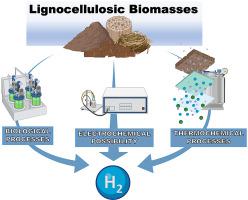Biomass & Bioenergy ( IF 6 ) Pub Date : 2020-12-08 , DOI: 10.1016/j.biombioe.2020.105920 Thibaut Lepage , Maroua Kammoun , Quentin Schmetz , Aurore Richel

|
Hydrogen is viewed as a sustainable strategic alternative to fossil fuels, especially in the field of road and air transport. Currently, hydrogen production is derived from fossil fuels or is manufactured by splitting water. A novel option, H2-generation from lignocellulosic biomass, based on renewable resources is currently in a pilot-scale demonstration or at a commercial stage. The present study reviews the thermochemical, biological, and electrochemical approaches used for biomass-to-hydrogen. The advantages, limitations, and major improvements of each process are presented. A techno-economic assessment is also established based on the production cost, technology readiness level, and industrial scalability.
The objective is to allow industrial producers to visualise the degree of technological maturity of each option, clarify the necessary development efforts before reaching the commercial stage, determine the most relevant and competitive routes, and assess the suitability of biomass as a feedstock for renewable hydrogen production.
In the reviewed results, the thermochemical process, particularly gasification, partial oxidation, and steam reforming, presented the best yield for H2 production. Steam gasification is the best compromise because it is suitable for wet and dry biomass, and it does not require an oxidising agent. As for biological conversion, dark fermentation is more worthwhile than photo-fermentation due to its lower energy consumption. Additionally, the electrochemical process is feasible for biomass.
The findings of this study indicate that biomass-hydrogen-based processes are promising options that contribute to the H2 production capacity but require improvements to produce larger competitive volumes.
中文翻译:

生物质制氢:主要路线生产,工艺评估和技术经济评估的回顾
氢被视为替代化石燃料的可持续战略替代品,特别是在公路和航空运输领域。当前,氢的生产来自化石燃料或通过分解水来生产。基于可再生资源的从木质纤维素生物质产生H 2的新选择目前处于试验规模的示范阶段或处于商业阶段。本研究综述了用于生物质制氢的热化学,生物和电化学方法。介绍了每个过程的优点,局限性和重大改进。还基于生产成本,技术准备水平和工业可扩展性建立了技术经济评估。
目的是使工业生产商可视化每种选择的技术成熟程度,在进入商业阶段之前阐明必要的开发工作,确定最相关和最具竞争力的路线,并评估生物质作为可再生氢生产原料的适用性。
在审查的结果中,热化学过程(特别是气化,部分氧化和蒸汽重整)呈现出H 2生产的最佳收率。蒸汽气化是最好的折衷方案,因为它适用于干,湿生物质,并且不需要氧化剂。至于生物转化,由于其较低的能耗,暗发酵比光发酵更有价值。另外,电化学过程对于生物质是可行的。
这项研究的结果表明,基于生物质氢的工艺是有前途的选择,有助于提高H 2的生产能力,但需要进行改进以产生更大的竞争量。



























 京公网安备 11010802027423号
京公网安备 11010802027423号